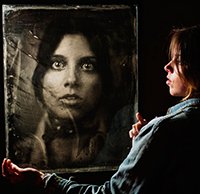Portrait photographer builds his own 16” x 20” camera in 10 hours
posted Wednesday, January 20, 2016 at 11:28 AM EDT

Nashville-based portrait photographer Giles Clement specializes in tintype and film portraits. He often utilizes older gear to give his images a timeless, classic appearance, but he recently built his own 16" x 20" camera.
Giles thought of the idea for this 16" x 20" camera while sitting in a coffee shop only last Friday. After sketching out his idea, as seen below, he called his friend Zach who stopped by Giles' studio an hour later to start the process of bringing Giles' sketches to life.
After a trip to Home Depot for wood and screws, they returned to the studio with 1/2 x 3" poplar for the back standard, 3/4 x 1" pine for the camera's main rail and front standard, in-floor heating tube pieces to act as dowels for the bellows support, and "really poor quality" 1/4" plywood for the lens board. The total cost for the materials was $168, with $70 being spent on 100 feet of 6 mil black bellows plastic (it is only sold in 100-foot rolls).
Cracking open a few beers and turning on James Bond theme music, Giles and Zach began cutting up materials and assembling pieces of the camera. Giles had calculated that the camera would need to be about five feet long to make a portrait, so he cut the bottom rail to that length. In addition to putting together the other components, they also needed ground glass. To grind the glass, Giles used an orbital sander and 100 grit sand paper. He says that the ground glass is not easy to view, but it is functional and good enough for now.
The front standard came next, which was a couple of pine pieces framed with plywood and a hole for the lens. The bellows were a cause for concern for Giles, as he had seen people spend hundreds or even thousands of dollars making or ordering bellows of the size he required, and he wanted to make this camera in a few hours and not spend that kind of money. His solution was to use telescoping support pieces using plastic tubes and wooden dowels. The 1/4" dowel slides into the 1/2" plastic tubing to allow for the camera to slide back and forth for achieving focus. The bellows themselves were actually taped together rather than stapled because both of the staple guns Giles and Zach had were broken.
Tens hour later, it was now time to test the camera out and make a photograph. Scrounging together the necessary materials at 2am, Giles poured the 16" x 20" plate and captured a portrait. Check out the full article to see more behind-the-scenes images of the camera building process and the first images that he made.

Giles says that "if I can find a bigger lens I'll probably drink a few more beers and try to make a 20" x 24" camera." I'm looking forward to seeing that!
(Seen via PetaPixel)